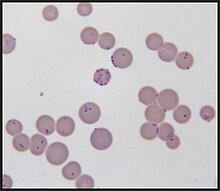It has been suggested that anything not having to do with the current Mycoplasma, i.e. everything except the two Phylogeny trees and the infobox be split out into another article titled Mollicutes. (Discuss) (November 2023) |
| Mycoplasma | |
|---|---|

| |
| Mycoplasma haemofelis | |
| Scientific classification | |
| Domain: | Bacteria |
| Phylum: | Mycoplasmatota |
| Class: | Mollicutes |
| Order: | Mycoplasmatales |
| Family: | Mycoplasmataceae |
| Genus: | Mycoplasma J.Nowak 1929 |
| Type species | |
| Mycoplasma mycoides (Borrel et al. 1910) Freundt 1955 (Approved Lists 1980)
| |
| Species | |
|
See text | |
| Synonyms | |
| |
| Mycoplasmosis | |
|---|---|
| Specialty | Infectious disease |
Mycoplasma is a genus of bacteria that, like the other members of the class Mollicutes, lack a cell wall, and its peptidoglycan, around their cell membrane.[1] The absence of peptidoglycan makes them naturally resistant to antibiotics such as the beta-lactam antibiotics that target cell wall synthesis. They can be parasitic or saprotrophic. Several species are pathogenic in humans, including M. pneumoniae, which is an important cause of "walking" pneumonia and other respiratory disorders, and M. genitalium, which is believed to be involved in pelvic inflammatory diseases. Mycoplasma species (like the other species of the class Mollicutes) are among the smallest organisms yet discovered,[2] can survive without oxygen, and come in various shapes. For example, M. genitalium is flask-shaped (about 300 x 600 nm), while M. pneumoniae is more elongated (about 100 x 1000 nm), many Mycoplasma species are coccoid. Hundreds of Mycoplasma species infect animals.[3]
In casual speech, the name "mycoplasma" (plural mycoplasmas or mycoplasms) generally refers to all members of the class Mollicutes. In formal scientific classification, the designation Mycoplasma refers exclusively to the genus, a member of the Mycoplasmataceae, the only family in the order Mycoplasmatales (see "scientific classification").
- ^ Ryan KJ, Ray CG, eds. (2004). Sherris Medical Microbiology (4th ed.). McGraw Hill. pp. 409–12. ISBN 978-0-8385-8529-0.
- ^ Richard L. Sweet, Ronald S. Gibbs (1985). Infectious Diseases of the Female Genital Tract. Lippincott Williams & Wilkins, 2009. ISBN 978-0-683-08038-4.
- ^ Larsen B, Hwang J (2010). "Mycoplasma, Ureaplasma, and Adverse Pregnancy Outcomes: A Fresh Look". Infectious Diseases in Obstetrics and Gynecology. 2010: 1–7. doi:10.1155/2010/521921. ISSN 1064-7449. PMC 2913664. PMID 20706675.